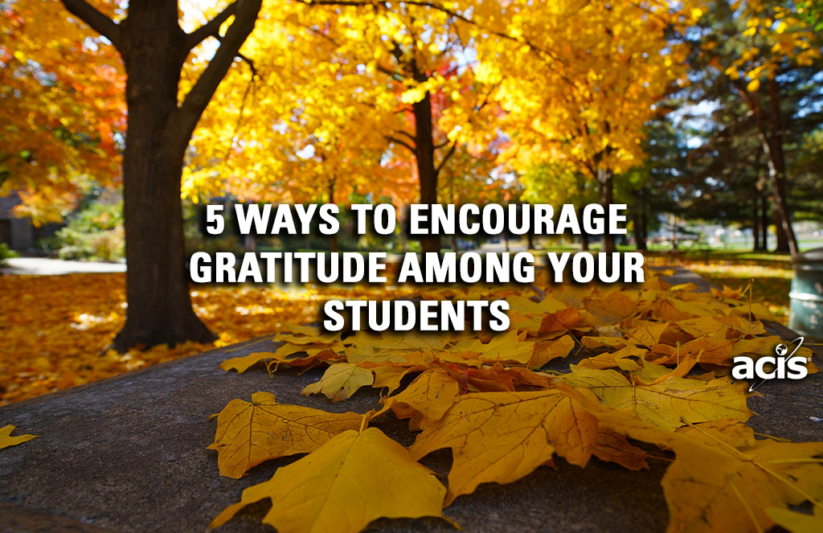5 Ways to Encourage Gratitude Among Your Students

Thanksgiving is coming, and aside from the delicious food we get to eat, it is our seasonal reminder to be grateful. Being grateful can be more complex than sitting around the Thanksgiving dinner table counting your blessings. It is a practice you can bring into your everyday life that can improve your overall well-being.
Over the past decade, psychologists have been successful in identifying the social, psychological, and physical health benefits that come from giving thanks. Practicing gratitude is an art. It’s something we all could do a little more, but it’s not always easy to effectively and consistently remind yourself to be aware of your blessings. Here are some effective ways to practice being grateful this holiday season that you can bring into your everyday life!
1. Journaling
One of the most popular ways to practice this in your everyday life is to keep a gratitude journal. Keeping a gratitude journal is straightforward. All you have to do is record five things you’ve experienced in the past week for which you are grateful. The entries can be just a single sentence and they can be as simple as “waking up this morning.”
To be successful in keeping a gratitude journal that actually reminds you to be grateful, here are some tips:
- Be present. Don’t just go through the motions. Staying motivated to become happier and more grateful will keep you focused while you record what you are grateful for.
- Go for depth over breadth. Sometimes you may not have 5 things to list. Rather than reaching for less meaningful things to complete the list, you will get more out of the practice by going into detail about the things you are truly grateful for.
- Subtract instead of add. Think about how different your life would be without certain blessings in them rather than just adding up everything you have.
- Savor surprises. Recording unexpected blessings that took you by surprise can give you stronger feelings of gratitude.
- Don’t overdo it. Writing when you want to is more beneficial than forcing yourself to write every day if your heart isn’t in it. The purpose of this exercise is to make you happier and more grateful, and that won’t be successful if it starts to feel like a chore. Designate one or two days a week to writing, and if you find yourself writing more often, your journal might be working!
Excerpted from Greater Good
2. Gratitude Jar
This is a great exercise for visually representing gratitude (a tricky thing to show sometimes):
- Step 1: Find a jar or box.
- Step 2: Decorate the jar with whatever makes you smile. You can tie a ribbon around the jar’s neck, put pictures of loved ones on the sides, use clear glue and glitter to make it sparkle, paint it, or do whatever else you can think of to make it a bright and happy sight!
- Step 3: This is the final most important step, which will be repeated every day. Think of at least three things throughout your day that you are grateful for. It can be something as small as a coffee at your favorite coffee shop, or as grand as the love of your significant other or dear friend. Do this every day, write down what you are grateful for on little slips of paper (bonus points for colored paper!), and fill the jar.
Over time, you will find that you have a jar full of a myriad of reasons to be thankful for what you have and enjoy the life you are living. If you are ever feeling especially down and need a quick pick-me-up, take a few notes out of the jar to remind yourself of what is good in your life.
Excerpted from Positve Psychology Program
3. Gratitude Prompts
Giving students journaling exercises centered around gratitude can help them build empathy and shift their attention away from the frenetic pace of their life. Try incorporating gratitude prompts like these:
- Tell me about a time you were grateful for something a friend did for you
- Tell me about a time you were grateful for someone helping you when you were hurt
- Tell me about your favorite place in your house
- What’s something unique about your family that you’re grateful for?
- Who’s someone you have never met that you are grateful for?
- Which of your five senses are you most grateful for?
- What technological advancement are you most grateful for?
- Who is someone you would like to send a thank you card to and why?
- Write about all the people who keep you safe.
- What are 3 ways to say “thank you” without using the words thank you?
Excerpted from Bounce Back Parenting
4. Gratitude Letter
This is a more in-depth gratitude practice, but it is profoundly effective. Think about someone in your life who has made a positive impact life. This could be a teacher, a friend, a grandparent, or anyone you have ever crossed paths with that you think has had a positive influence on you. Have you ever properly thanked them? If not, this is a practice you could use.
Sit down and write a letter to them. Thank them for what they have done and specify how it has affected you. It doesn’t have to be long, but express your gratitude in detail and you will both benefit.
5. Gratitude Meditation
Gratitude brings happiness, and practicing gratitude can put you at ease with yourself, your life, and those around you. Here is a gratitude meditation you can practice that will help you to look at every aspect of your life and remind you of all you have to be grateful for.
Let yourself sit quietly and at peace. Allow yourself to feel relaxed and open. Begin the practice of gratitude by feeling how year after year you have cared for your own life. Now let yourself begin to acknowledge everything that has brought you to this moment:
With gratitude I remember the people, animals, plants, insects, creatures of the sky and sea, air and water, fire and earth, all whose joyful exertion blesses my life every day.
With gratitude I remember the care and labor of a thousand generations of elders and ancestors who came before me.
I offer my gratitude for the safety and well-being I have been given.
I offer my gratitude for the blessing of this earth I have been given.
I offer my gratitude for the measure of health I have been given.
I offer my gratitude for the family and friends I have been given.
I offer my gratitude for the community I have been given.
I offer my gratitude for the teachings and lessons I have been given.
I offer my gratitude for the life I have been given.
Just as we are grateful for our blessings, so we can be grateful for the blessings of others.
Continue to breathe gently. Bring to mind someone you care about, someone it is easy to rejoice for. Picture them and feel the natural joy you have for their well-being, for their happiness and success. With each breath, offer them your grateful, heartfelt wishes:
May you be joyful.
May your happiness increase.
May you not be separated from great happiness.
May your good fortune and the causes for your joy and happiness increase.
Sense the sympathetic joy and caring in each phrase. When you feel some degree of natural gratitude for the happiness of this loved one, extend this practice to another person you care about. Recite the same simple phrases that express your heart’s intention.
Then gradually open the meditation to include neutral people, difficult people, and even enemies- until you extend sympathetic joy to all beings everywhere, young and old, near and far.
This excerpt is taken from the book, “The Art of Forgiveness, Lovingkindness, and Peace“









